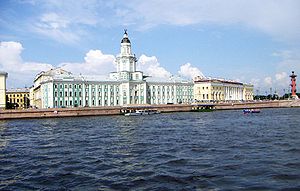Contents
Fersman Mineralogical Museum (Russian: Минералогический музей им. А. Е. Ферсмана) is one of the largest mineral museums of the world, located in Moscow, Russia. Its collections include more than 135,000 items. Among them natural crystals, geodes, druses and other kinds of mineral treasures. The museum was named after Alexander Fersman.

History
Early history
The museum was founded in 1716 in Saint Petersburg.
On 5 December 1747 a great fire destroyed virtually the whole collection. In 1836 the Kunstkamera was divided into 7 separate museums, including Mineralogical museum which was moved to the new building. In 1898 the museum was expanded and renamed the Geological museum.
In Moscow
Museum was moved from Petersburg to Moscow in 1934 together with the Russian Academy of Sciences.
Collections

All museum acquisitions since 1716 were divided at the beginning of 20th century by the academician Vladimir Vernadsky to 5 main collections:
- Systematic collection.
- Crystal collection.
- Locality collections.
- Pseudomorph collection.
- Gems and stone art collection.
Directors

- 1835–1845 Grigori Gelmersen
- 1845–1857 Konstantin Grevingk
- 1857–1866 Adolf Gebel
- 1866–1873 Nikolai Koksharov
- 1873–1900 Fyodor Shmidt
- 1900–1906 Feodosy Chernyshov
- 1906–1919 Vladimir Vernadsky
- 1919–1945 Alexander Fersman
- 1930–1945 Vladimir Kryzhanovsky (executive director)
- 1945–1945 Vladimir Kryzhanovsky
- 1947–1953 Dmitry S. Belyankin
- 1953–1976 Georgi Barsanov
- 1976–1980 Yuri Orlov
- 1980–1982 Vladimir Sobolev
- 1983–1995 Aleksandr Godovikov
- 1995–2010 Margarita Novgorodova
- 2011–2015 Viktor Garanin
- 2016–present Pavel Plechov[1]
References
- ^ "The history of Fersman Mineralogical Museum 1 - Минералогический музей имени А. Е. Ферсмана РАН". www.fmm.ru. Retrieved 2020-05-18.
External links
- Photo (1024x768)
- (in Russian and English) Fersman Mineralogical Museum home page
- (in Russian) Article in the GeoWikipedia

